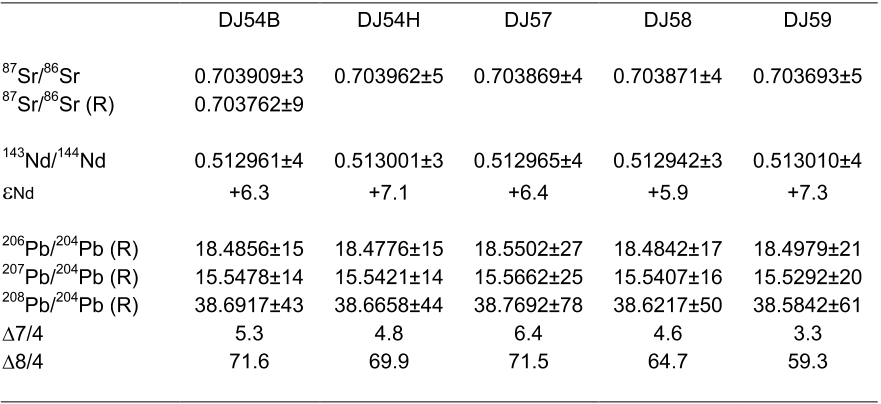A LREE-depleted component in the Afar plume; further evidence from Quaternary Djibouti basalts
Figures (8)

Table 2 (continued).4 5 
Table 2 (continued).4 5 
Table 3 Click here to download Table: Hayy_Table 3nb.doc 
Table 1. Unspiked 40K-40Ar datings of Hayyabley basalts. See text for the analytical 1 procedures. 2 3 
Table 1.5 
Table 4. Sr, Nd and Pb isotopic compositions of Hayyabley basalts (B: bulk rock; R: residue 1 after leaching). See text for the analytical procedures. Δ7/4 and Δ 8/4 denote the deviation (in 2 0/00) of 
Table 4. Sr, Nd and Pb isotopic compositions of Hayyabley basalts (B: bulk rock; R: residue 1 after leaching). See text for the analytical procedures. Δ7/4 and Δ 8/4 denote the deviation (in 2 0/00) of 
Table 3 Click here to download Table: Hayy_Table 3nb.doc
Citations
62 citations
Cites background from "A LREE-depleted component in the Af..."
...…Thirlwall et al., 2004; Kokfelt et al., 2006], the Galapagos [White et al., 1993;Hoernle et al., 2000; Blichert-Toft and White, 2001; Saal et al., 2007], Afar [Furman et al., 2006; Beccaluva et al., 2009; Daoud et al., 2010] and Hawaii [Yang et al., 2003; Frey et al., 2005; Fekiacova et al., 2007]....
[...]
46 citations
45 citations
42 citations
Cites background from "A LREE-depleted component in the Af..."
...Analogues of the Karelian Palaeoproterozoic continental MORB-type tholeiities have been recognized in the North Atlantic and Afar continental flood basalt provinces, where depleted MORB-type tholeiitic basalts are shown to have formed simultaneously with high-Ti basalts (Barrat et al., 2003; Daoud et al., 2010; S ager & Holm, 2011;Waight & Baker, 2012)....
[...]
..., 2012), and dikes (this study) compared with low-Ti tholeiites from the Faroe Islands (S ager & Holm, 2011), depleted basalts from Central East Greenland (Waight & Baker, 2012), LREE-depleted basalts from Central Afar (Barrat et al., 2003; Daoud et al., 2010), Kolbeinsey Ridge and Reykjanes Ridge basalts (PetDB), and global N-MORB (PetDB)....
[...]
...MORB-type continental tholeiitic basalts are thought to have formed as a result of melting of depleted mantle components in mantle-plume source regions (Daoud et al., 2010; S ager & Holm, 2011; Waight & Baker, 2012)....
[...]
..., 1990; Perttunen & Hanski, 2003); Fe^Ti basalts and low-Ti basalts, Faroe Islands (S ager & Holm, 2011); Fe^Ti basalts and depleted basalts, Central East Greenland (Waight & Baker, 2012); LREE-depleted basalts, Central Afar (Barrat et al., 2003; Daoud et al., 2010)....
[...]
References
84 citations
"A LREE-depleted component in the Af..." refers background in this paper
...Once again, such a mantle is 358 expected to be LREE-enriched (Hart et al., 1989; Vidal et al., 1991; Deniel et al., 1994) and 359 thus should transmit its trace element and isotopic fingerprint to LREE-poor ascending 360 magmas....
[...]
...…authors have suggested that melting of the Afar lithospheric mantle explains a 41 significant proportion of the erupted lavas (Hart et al., 1989; Vidal et al., 1991; Deniel et al., 42 1994) whilst others point out that continental crust contamination can also contribute to the 43 isotopic…...
[...]
84 citations
"A LREE-depleted component in the Af..." refers background in this paper
...4 to 6) point to the participation of two mantle end-members, namely a 399 HIMU component and a depleted mantle (DM) component undistinguishable from the source 400 of the Red Sea MORB (Barrat et al., 1998)....
[...]
...Our new results confirm the presence within the Afar 450 region of basalts derived from an uncommon depleted component, isotopically distinct from 451 the source of the Red Sea MORBs and from the similarly depleted mantle (DM in Figs....
[...]
...4 to 452 6) which contributes to the genesis of Erta„Ale volcanics (Barrat et al., 1998)....
[...]
...…basalts from the East of the Gulf of Tadjoura 820 and the Aden Gulf (Barrat et al., 1990, 1993; Schilling et al., 1992), (3) Erta „Ale volcanics 821 (Barrat et al., 1998), (4) LREE-depleted basalts from Manda Hararo (MH, Barrat et al., 2003), 822 and (5) some Ethiopian samples (E88: depleted…...
[...]
...The studies of meteorites from Sahara have demonstrated that 315 some of them, and not only the most weathered ones, exhibit marked Ba and Sr enrichments 316 that are sensitive indicators of the development of secondary calcite, gypsum, or barytes (e.g., 317 Barrat et al., 1998, 2003)....
[...]
83 citations
82 citations
79 citations